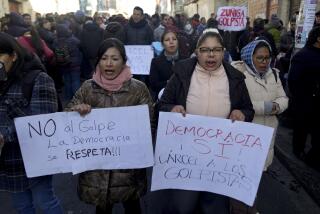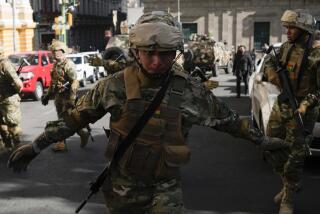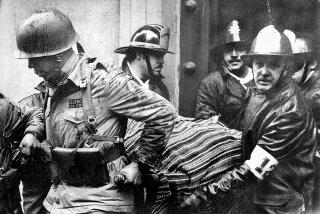Noriega Flees; Reward Posted : 15 GIs Killed as U.S. Forces Topple Panama Regime : Latin America: Key objectives achieved, Bush declares. White House offers $1 million for information leading to dictatorâs capture.
WASHINGTON â A massive U.S. invasion force on Wednesday overthrew the regime of Panamanian strongman Manuel A. Noriega, chasing the dictator into hiding with an air and infantry assault that left at least 15 American GIs dead.
The White House offered a $1-million reward for information leading to Noriegaâs capture.
As airlifted troops prepared to storm Panamanian military bases, a justice in Panama swore into office the opposition leaders who would have been swept into office last May, observers believe, if Noriega had allowed a vote count.
The three--presidential candidate Guillermo Endara and the two successful vice presidential candidates, Ricardo Arias Calderon and Guillermo Ford--took their oaths of office at an American military base. But their whereabouts were kept secret throughout the day, an indication of the uncertain military situation.
âKey military objectives have been achieved,â President Bush declared in a dramatic announcement televised from the Oval Office at dawn, about six hours after the operation began. âMost organized resistance has been eliminated. Gen. Noriega is in hiding. Yesterday, a dictator ruled Panama, and today, constitutionally elected leaders govern.â
Bush cited four reasons for the invasion, the first undertaken by his Administration:
-- To protect the lives of the 35,000 Americans in Panama, who Bush said were in âimminent danger.â
-- âTo defend democracyâ there.
-- To seize Noriega, who is wanted on federal drug-trafficking indictments in this country.
-- To protect U.S. rights under the Panama Canal Treaties.
Bush said he is committed to the terms of the treaties, which call for handing the canal over to Panama in the year 2000.
The invasion, christened Operation Just Cause, was launched at midnight in Panama after military airlifts nearly doubled the U.S. force in the nation, to more than 20,000 troops.
More than 100 Americans were wounded in the fighting, and they were airlifted to Wilford Hall Air Force Medical Center in San Antonio.
In addition to the military casualties, one GI was reported missing and an unidentified female civilian dependent living in Panama was said to have been killed. Four helicopters were shot down.
The attack left the entire neighborhood around the headquarters of Noriegaâs Panama Defense Forces in flames and the bodies of Noriega loyalists littering the streets, according to reports from Panama.
According to a pool report filed by reporters flown to Panama by the Air Force, fires continued to rage at the gutted headquarters of the Defense Forces and in an adjacent three-block area of the old quarter of Panama City 12 hours after the invasion began.
Noriega loyalists engaged the U.S. troops in firefights, which Army Gen. Colin L. Powell, chairman of the Joint Chiefs of Staff, said were responsible for the 15 American deaths.
Sporadic fighting was said to have continued into the afternoon Wednesday. Army Lt. Gen. Thomas W. Kelly, a member of the staff of the Joint Chiefs of Staff, said the Pentagon hoped to complete âmopping upâ operations within three days.
Only one unit--the Panamanian 1st Infantry--was putting up organized resistance, operating north of Panama City, according to members of Congress who were briefed by senior Pentagon and State Department officials.
Battalion 2000, one of the Noriega units that harassed opposition figures, no longer exists after a brief firefight with U.S. troops, members of Congress reported. But they said a Defense Forces radio station continued to operate from the 14th story of a building and was believed to be sending out coded messages.
However, according to Reuters news service, the station was knocked off the air Wednesday night when a U.S. helicopter poured rocket fire into the building.
At one point during the day, Noriega broadcast a 52-second radio address from an undisclosed location, congratulating his forces and urging Panamanians to âresist and advance. Our rallying cry is to overcome or die, not to step backwards, and to come forward the victors,â he said. He also appealed for world help.
The U.S. Embassy in downtown Panama City came under fire and suffered minor damage, but no injuries were reported to Americans there. But there were conflicting reports about Americans being held hostage by Panamanian troops, who temporarily overran the Marriott Hotel near the embassy.
Unconfirmed reports said 16 Americans were being held, but U.S. officials said late Wednesday that there were no U.S. hostages, although about 60 Americans were believed to be âtrapped in certain areasâ by the fighting.
Members of the 82nd Airborne arrived at the Marriott late Wednesday to evacuate the 30 or 40 people trapped inside, Associated Press reported. The divisionâs arrival was preceded by air cover and light arms fire.
A variety of sources in Washington, meanwhile, reported that from 250 to 800 Noriega loyalists were being detained as prisoners by the U.S. forces.
Even as Army Ranger paratroopers were dropped out of the night skies from C-130s and Apache helicopters flew in a line over the strife-torn country, the Bush Administration launched a wide effort to win international support for the operation.
But it was criticized by Soviet leaders, who were alerted to the invasion when the White House dispatched a cable to the Kremlin about the time the operation began. It was also overwhelmingly condemned by Latin American governments, which refused to recognize the leadership installed 40 minutes before the overthrow got under way. But some West European governments, including Britain, offered verbal support.
As described by Powell, the invasion had three prongs, with operations in the central Panama Canal Zone, near the international airport and to the west near Rio Hato.
The forcesâ immediate military objectives--apparently achieved--were to gain control of key Panamanian military bases, a prison holding about 50 Defense Forces dissidents who took part in an unsuccessful coup against Noriega on Oct. 3, an electrical power plant and the Bridge of the Americas crossing the Panama Canal. Among the prisoners who were freed, a Pentagon source said, was an American CIA agent held in Panama since April.
Sources said the agentâs last name was Muse and that his first name was Carlton or something similar.
But Noriega eluded the 13,000 U.S. troops deployed in Panama, the 7,500 troops airlifted in Monday and Tuesday and reinforcements sent in Wednesday.
Elite commandos were dispatched throughout the countryside to find him, and weapons caches he had established throughout Panama were said to be under surveillance.
âWe have every spigot turned on to find Mr. Noriega. Weâre turning on all our looking, listening and hearing devices,â Lt. Gen. Kelly said. âWe have a concern that heâs gone off into the jungle.â
Officials expressed little surprise that Noriega appeared to have advance word of the assault.
âWhen you watch a lot of C-141s roll in, itâs a dead giveaway. And unfortunately, it just took a lot of C-141s for the U.S. to get down there,â one Pentagon official said. Indeed, the giant jet cargo planes began stepped-up flights to Howard Air Force Base in Panama on Monday.
But Powell expressed doubts about Noriegaâs ability to avoid the dragnet.
âItâs been some years since (Noriega), the fugitive, has been seen in the jungle, living in the jungle. Heâs used to a different kind of life style, and Iâm not quite sure he would be up to being chased around the countryside by Army Rangers, Special Forces and light infantry units of the Joint Operations Training Center,â Powell said.
But, acting on the assumption that they might not be able to find Noriega immediately, U.S. troops and intelligence forces moved quickly to disable Panamanian ships, shut down all airstrips and set up roadblocks, U.S. officials said.
For nearly two years, Noriega has been a festering wound in the side of American foreign policy, successfully fending off economic and diplomatic pressure. He held onto power that he enforced through the ruthless activities of the so-called Dignity Battalions and the Panama Defense Forces, of which he was commander. Stiff economic sanctions intended to cut off most U.S. business with Panama were imposed by the Reagan Administration, but they failed to weaken Noriegaâs grip.
Last May, Endara, Ford and their supporters came under bloody attack from Noriega supporters when they tried to claim the offices that independent election observers agreed they had won. Bush at that time called for the Defense Forces to overthrow Noriega. But the President came under sharp criticism in early October when he made only limited U.S. support available for what turned out to be an unsuccessful coup attempt.
The crisis came to a head last weekend when an unarmed U.S. Marine officer in civilian clothes was shot and killed in a confrontation with Panamanian troops in front of their headquarters; a Navy lieutenant was seized temporarily and his wife threatened with sexual abuse, and other Americans were harassed. In addition, Noriegaâs rubber-stamp legislature declared Friday that a state of war existed with the United States.
Bush called his senior advisers, including Vice President Dan Quayle, Secretary of State James A. Baker III, Defense Secretary Dick Cheney and National Security Adviser Brent Scowcroft, to a secret meeting at the White House on Sunday to review military options and begin the final updating of a Pentagon plan initially drawn up before the Administration took office Jan. 20.
Baker said Wednesday that Bush felt he faced greater danger from inaction than from using the military to overthrow Noriega.
One of the key factors prompting Bush to act was intelligence that Noriega had a 250-member paramilitary unit standing by to attack what Sen. John Warner of Virginia, the ranking Republican on the Senate Armed Services Committee, described as âa designated segment of Americans in their housing units.â In the Presidentâs mind, this threat eclipsed the knowledge that U.S. intelligence was not certain about Noriegaâs location, congressional sources said.
Bush spent most of Tuesday night and the pre-dawn hours of Wednesday in the Oval Office and his adjacent study.
Dressed casually in a dark blue sweater and slacks, the President received reports of the troop movements and initial fighting from Scowcroft, while he, Quayle and Baker contacted foreign leaders in an effort to gain support for the mission. A television set carried live reports.
Bush napped briefly in the early morning and then addressed the nation by television from the Oval Office as the day broke.
âI took this action only after reaching the conclusion that every other avenue was closed and the lives of American citizens were in grave danger,â Bush said.
Times staff writers Robin Wright, Sara Fritz, John M. Broder, Melissa Healy and Norman Kempster contributed to this story.
CHANGE AT TOP--Opposition leader Guillermo Endara is sworn in as president--long after winning an election nullified by Noriega. A5
LATIN CONDEMNATION--Leaders in Latin America overwhelmingly deplore the U.S. action. A6
MEDIA SHOW--The invasion was broadcast live--but networks had to use reportersâ words to paint warâs searing images. A7
HOSTAGES TAKEN--Loyalists seized more than a dozen foreigners, including Americans. Some were released, but others may still be held. A8
TRUCE SOUGHT--Noriegaâs U.N. envoy asked the Security Council to appeal for a cease-fire. A11
U.S. FIRMS CLOSE--When the fighting erupted, U.S. businesses quickly shut their doors. D1
More to Read
Sign up for Essential California
The most important California stories and recommendations in your inbox every morning.
You may occasionally receive promotional content from the Los Angeles Times.










